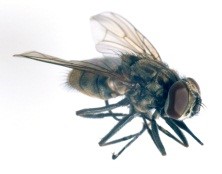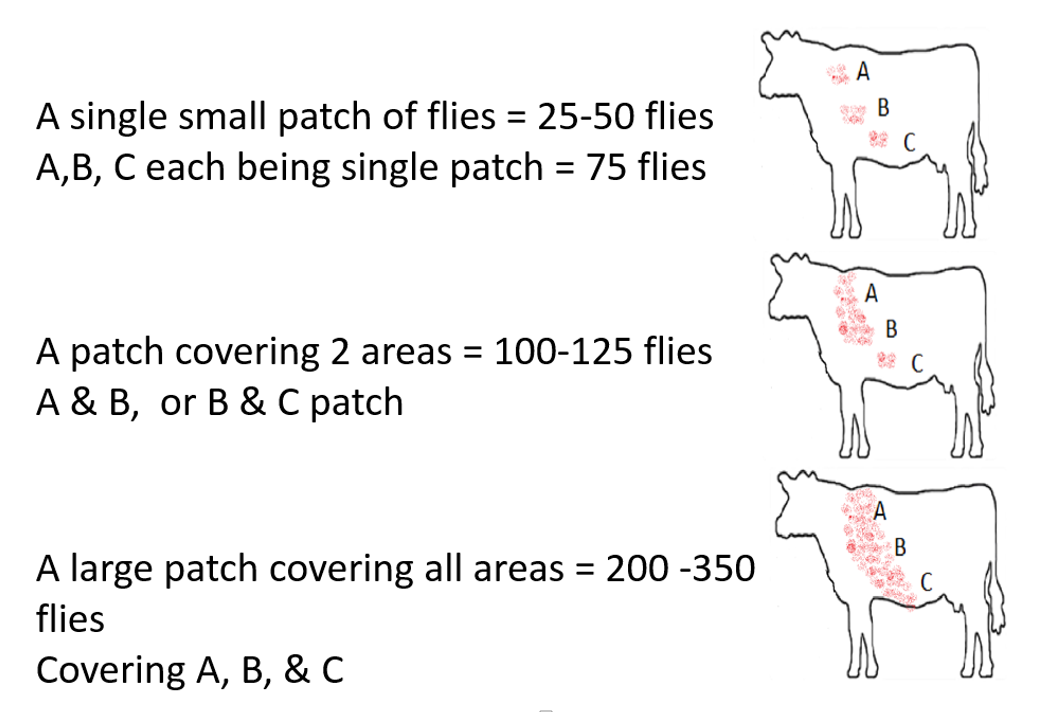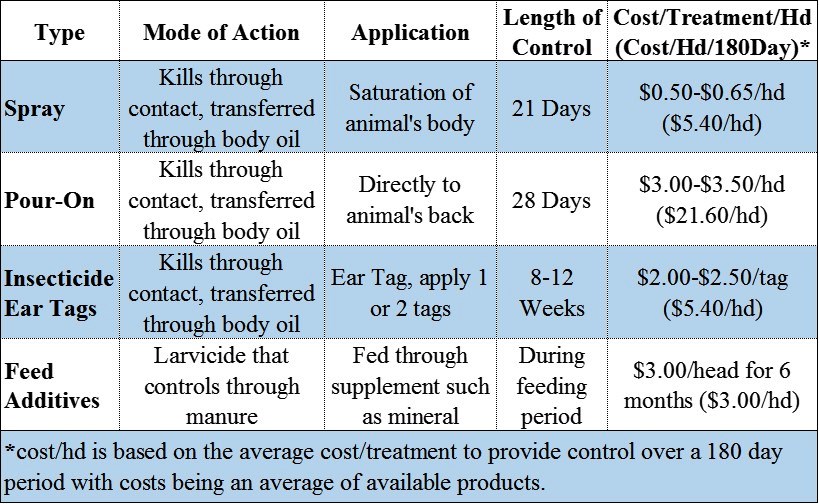With a warm winter in the southeast and an early spring, many producers are already noticing the presence of flies in their beef cattle herds. The most common and costly of these flies is the Horn Fly. It is estimated that economic losses due to horn flies are $36 million per year in Florida. Horn flies affect cattle performance through blood feeding and irritation. Cattle impacted by horn flies can lose 0.3 to 0.5 lbs in body weight per day. With April cattle prices, a loss of 0.5 lbs/ day would equate to an estimated $0.87 hd/day in a typical beef cattle operation. In a 30 head herd that would be $26.10 daily or $783 monthly. Thus, producers need to gear up for fly season by developing a management plan to mitigate profit losses from Horn Flies as warmer weather sets in.
Eggs are laid in fresh cattle manure (within 10 minutes of dropping) and within 18 hours larva hatch out. Development from egg to a sexually mature fly takes from 10 to 14 days (Figure 1). Each female can then produce up to 200-500 eggs, with each adult living between 2 and 4 weeks. This short and highly productive life cycle results in a quick increase in Horn Fly populations.
Research indicates that 200 flies/animal is the economic threshold at which implementing fly control becomes profitable. In beef cattle herds fly populations per animal can be easily estimated (Figure 2), however if cattle seem restless, switching their tails or kicking at their bellies, often times there is enough irritation to warrant treatment.
While resistances to treatment is an increasing concern with all livestock pests, Horn Fly populations can be effectively controlled to reduce animal discomfort and economic losses to producers. There are many methods of Horn Fly control that can be implemented in a grazing pasture system. It is recommended that control methods be rotated between active ingredients to reduce resistance. For example if you use Fly Tag X this year, next year use Fly Tag Y. There are a wide range of products and methods available to producers to utilize for fly control (Table 1).
Insecticide Tags: In the 1970’s when fly tags were first introduced, they were very effective, however this success was short lived as resistance developed. Pharmaceutical companies have done a good job working to develop alternative chemicals that can be rotated to increase effectiveness. Tags are placed in cattle’s ears, and through grooming and contact with hair coat, the oils from the hair triggers the transfer of the insecticide to the animal. Tags are impregnated with enough chemical to control flies for 8 to 12 weeks. After 12 weeks the insecticide in the tags becomes weaker allowing greater opportunity for flies to develop resistance to the chemical.
Following application, if tags are not effectively controlling fly populations, research indicates that you are experiencing a resistance issue. The tags may still be controlling the majority of the flies, but the flies that are not being controlled are more than likely resistant to the treatment. In this case, you should remove the tags immediately and switch to an alternative insecticide. Otherwise these resistant flies will become successful breeders, and develop into a resistant population.
Pour On: A liquid drench can be applied to the back line of cattle. While the drench is only applied along the back, it moves through the oils in the skin and hair to provide control over the animal’s entire body. However, this type of control is only temporary, resulting in the need for reapplication. In most cases, depending on the product used and the weather around time of application, it will be effective for approximately 28 days.
Spray: Insecticide sprays are used to control the animals in a body drenching fashion to provide fly control. The key is to use enough pressure to penetrate to the skin and not just on the hair coat. Since the chemical is diluted with water for application, the key is to saturate the entire animal, as the product will not move as effectively though the animal’s body oil. In addition, because it is not bound to the oils on the body, sprays are much more likely to be washed off by rain events.
Feed Additives: Oral larvicides can be included in supplemental feed such as mineral to control flies. These growth regulator insecticides are passed through to the manure and kill the fly larvae as they develop in the manure, but have no effect on adult flies. This treatment method is most effective if all the cattle in your area are being treated to reduce Horn Fly populations. Research has shown that flies will travel between 0.5 to 1 miles to find untreated hosts.
Horn Flies are a costly issue that cattle producers are forced to deal with. The good news, however, is that the technology have been developed for effective control to minimize production losses. Dr. P. E. Kaufman is an expert in Horn Fly management at the University of Florida. He encourages producers to “manage the population, not try to exterminate them.” In an effort to provide producers with tools to help do so, he collaborated in a multi-state effort to develop an online system for obtaining the names of registered pesticides appropriate for use with livestock and pets. Here is the link to that online system: Insect Pests of Animals. For additional information also please see the following UF/IFAS publication: Horn Fly Management
- Summer Mineral Consumption for Cattle on Pasture - July 11, 2025
- Hens in the Heat - July 11, 2025
- Horn Fly Control In Cattle - June 20, 2025



